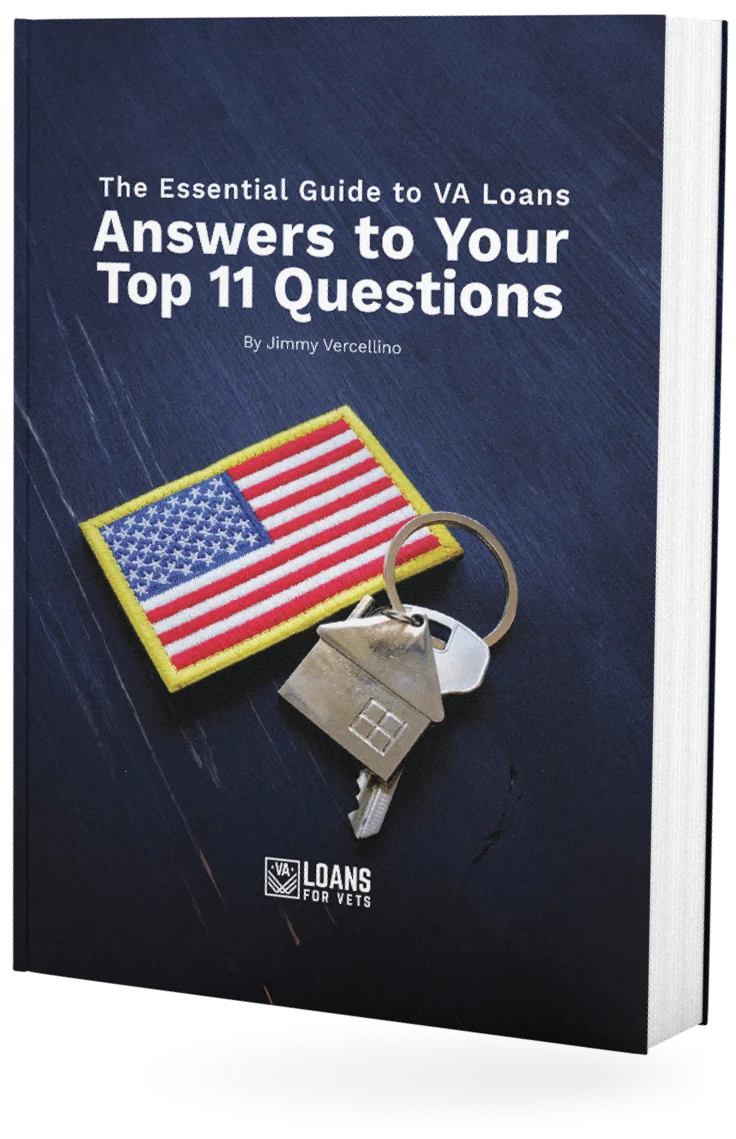Navigating the complexities of VA mortgage underwriting guidelines can be a daunting task for potential homebuyers. Fortunately, expert VA Loan Mortgage Broker, Jimmy Vercellino from VALoansforVets.com, offers a wealth of knowledge in this realm. With years of specialized experience catering to veterans and active-duty military members, Jimmy has a unique insight into the nuances and intricacies of VA loans. Through his comprehensive understanding and dedication, he has helped countless veterans achieve their dream of homeownership while demystifying the often confusing landscape of VA loan requirements and processes. Whether you’re a first-time homebuyer or looking to refinance, Jimmy Vercellino’s expertise is an invaluable resource for all things related to VA mortgages.
These loans are designed to help veterans become homeowners by providing flexible and affordable financing options. However, in order to ensure that the loans are granted responsibly, there are certain VA Loan underwriting guidelines that need to be followed.
A Quick Overview of VA Loans
VA loans, or Veterans Affairs mortgages, are a type of home loan backed by the U.S. Department of Veterans Affairs, designed specifically for active-duty military members, veterans, and certain eligible spouses. These loans come with distinct advantages, such as competitive interest rates, reduced down payment requirements, and the absence of private mortgage insurance (PMI).
For those eager to dive deeper into the world of VA loans, Jimmy Vercellino’s YouTube channel serves as a goldmine of information. With a series of insightful videos that cover everything from the basics to advanced topics, Jimmy provides viewers with a comprehensive understanding of the VA loan process. Whether you’re a novice or someone familiar with home buying, his channel offers invaluable insights to empower and guide you through your VA loan journey.
The Importance of VA Mortgage Underwriting Guidelines
Underwriting guidelines are the set of rules and requirements that lenders must adhere to when evaluating loan applications. These guidelines ensure that the loan is granted to borrowers who are financially capable of repaying the debt. By following VA mortgage underwriting guidelines, lenders can minimize the risk of defaults and foreclosures.
Role of Loan Underwriting in Loan Approval Process
Underwriting plays a crucial role in the mortgage loan approval process. It involves assessing the borrower’s financial situation, creditworthiness, and the value of the property being purchased. The underwriter’s goal is to determine whether the borrower meets the lender’s criteria for approval and can responsibly handle the financial obligations.
Loan Limits in the Underwriting Process
In the underwriting process of VA loans, the loan limit plays a crucial role in determining how much a veteran or active-duty member can borrow without requiring a down payment. Historically, the Department of Veterans Affairs set specific loan limits based on county-by-county data, reflecting the cost of housing in those regions. However, as of January 1, 2020, the Blue Water Navy Vietnam Veterans Act removed the VA loan limit for borrowers with full VA loan entitlement. This means that veterans and military members can potentially secure a VA-backed mortgage without a down payment, irrespective of the loan amount, as long as they meet the lender’s credit and income requirements. Yet, for those with reduced entitlement, either from previous VA loan usage or loan defaults, loan limits may still apply. Given the nuances, borrowers are advised to consult with knowledgeable lenders, such as Jimmy Vercellino, to understand how these limits might impact their borrowing capabilities.
Benefits of Following Underwriting Guidelines
Following VA mortgage underwriting guidelines benefits both lenders and borrowers. For lenders, it helps reduce the risk of default and ensures that loans are granted to financially stable individuals. For borrowers, it provides a clear understanding of the requirements and enhances their chances of loan approval.
Manual Underwriting on VA Loans
Manual underwriting is a hands-on, detailed review process within the realm of VA loans, especially when a borrower doesn’t meet the standard requirements set forth by automated underwriting systems. Instead of relying solely on software, the mortgage process is overseen by human underwriters who delve deeper into a borrower’s financial situation, ensuring that veterans and active-duty members are given a fair shot at homeownership even if their credit scores or financial metrics aren’t pristine.
One significant aspect of manual underwriting is the focus on residual income, which refers to the income left over after all major expenses have been paid. Residual income can provide a more accurate picture of a borrower’s ability to manage a new mortgage, especially if they have a lower credit score. During this process, a borrower might receive a conditional approval, meaning the loan will be approved provided certain conditions are met. This could include anything from clearing up discrepancies in credit history to providing a letter of explanation for derogatory credit events. Such letters offer borrowers an opportunity to clarify any adverse events, like bankruptcies or late payments, by providing context that an automated system might overlook.
Moreover, while credit scores are a significant focus in the automated mortgage process, manual underwriting places greater emphasis on a borrower’s entire credit history. This comprehensive approach benefits veterans who might have faced financial hardships in the past but have since demonstrated fiscal responsibility. However, manual underwriting may come with additional requirements or more stringent scrutiny of documents to compensate for perceived risks. This makes it essential for borrowers to be transparent and work closely with their lenders to navigate any challenges that arise during the underwriting phase.
Definition and Purpose of Manual Underwrite
Manual underwriting in the VA loan arena serves a pivotal function, especially when the automated underwriting systems (AUS) fall short of capturing the full financial portrait of a borrower. Given the unique financial challenges that veterans and active-duty members might face, this manual process ensures that they are not unfairly excluded from the mortgage or refinance loan opportunities based solely on automated metrics.
While many VA lenders predominantly rely on the automated system for a quick and streamlined evaluation, they recognize that a credit score is just one facet of a borrower’s financial reliability. Manual underwriting provides a platform for VA lenders to look beyond that number, examining the broader credit history, past financial decisions, and current economic standing. This is particularly crucial when veterans or active-duty members are seeking a refinance loan to take advantage of lower interest rates or better loan terms, but their credit score doesn’t meet the typical AUS criteria.
Upon diving deeper into an applicant’s financial details during manual underwriting, many lenders might offer a conditional approval. This indicates that while the borrower shows promise, certain conditions, whether related to credit history clarification or additional documentation, must be satisfied before the loan is fully approved. It’s worth noting that even if one VA lender denies an AUS approval, it doesn’t universally disqualify a borrower. With the manual underwriting process, many lenders are equipped to discern and understand the unique financial narratives of veterans, making it a vital component in ensuring they have equitable access to home financing options.
Advantages and Disadvantages of Manual Underwriting
Manual underwriting has its advantages and disadvantages. On the positive side, it allows more flexibility in evaluating loan applications and takes into account individual circumstances that may not be considered by an automated system. However, the manual underwriting process can be more time-consuming and may require additional documentation from the borrower.
How a VA Loan Broker Helps in the Underwriting Process
A VA loan mortgage broker plays a pivotal role in guiding customers through the underwriting process, especially given the distinct nature of VA loans. Here’s how they assist:
1. VA Loan Education
Jimmy, being a veteran himself, understands firsthand the importance of thorough education on VA loans. He offers a tailored approach to explain the process, ensuring his fellow veterans and active-duty members are equipped with all the knowledge they need to make informed decisions.
2. Pre-qualification Guidance
With years of experience, Jimmy knows how to evaluate a borrower’s financial stance accurately. He provides invaluable advice on how veterans can position themselves best before the application to maximize their loan potential.
3. Document Preparation and Collection
Jimmy’s familiarity with the military documentation, combined with his deep knowledge of VA loan requirements, ensures that all paperwork is meticulous. His team’s precision accelerates the approval process.
4. Loan Customization
Jimmy’s personal experience as a veteran allows him to resonate with the unique needs of military families. By tapping into this, he can tailor loan solutions that genuinely fit individual circumstances.
5. Application Submission
Having processed countless VA loan applications, Jimmy has an adept understanding of potential pitfalls. He meticulously reviews every application to avoid any missteps, ensuring smooth sailing through the underwriting phase.
6. Liaising with Underwriters
His longstanding relationships with underwriters enable efficient communication. If any concerns arise, Jimmy’s rapport ensures they’re addressed swiftly, avoiding unnecessary delays.
7. Addressing Credit Issues
Understanding the challenges some veterans face post-service, Jimmy provides compassionate and practical advice on handling credit issues, leveraging his extensive experience to offer solutions that other brokers might overlook..
8. VA Appraisal Process
Jimmy ensures that veterans aren’t blindsided by property issues. By coordinating the VA appraisal process, he confirms that the property not only meets VA standards but also serves the best interests of the veteran.
9. Clarifying Loan Conditions
With a commitment to clarity, Jimmy deciphers complex loan conditions for borrowers, ensuring they’re met promptly. His proactive approach minimizes the chance of last-minute surprises.
10. Negotiating Rates and Terms
Jimmy’s reputation and expertise position him as a formidable negotiator. He ardently advocates for his clients, ensuring they get the most favorable rates and terms.
11. Streamlining the Closing Process
Having walked countless veterans to their homeownership dreams, Jimmy knows the importance of a smooth closing. He orchestrates the final steps meticulously, making sure every detail is in place for a successful conclusion.
Having a VA loan mortgage broker like Jimmy Vercellino, who specializes in VA loans, ensures that borrowers benefit from the unique advantages of the program while navigating the complexities of underwriting. Their expertise provides a buffer against potential hiccups, ensuring the path to homeownership is as seamless as possible for veterans and active-duty military members.
The Underwriting Process for VA Loans at VAloansforVets
The underwriting process for VA loans is a critical phase that determines whether a loan application will be approved, and at what terms. It involves several key steps:
- Pre-qualification: Before diving deep into the underwriting process, lenders typically evaluate a potential borrower’s financial position to provide a rough estimate of the loan amount one might qualify for.
- Loan Application: The borrower submits a detailed application providing all necessary financial information, including income, debts, and assets.
- Document Collection: The lender gathers essential documents such as pay stubs, tax returns, bank statements, and other related papers to verify the borrower’s financial situation.
- VA Appraisal: Unique to VA loans, an appraisal is ordered to assess the property’s value and ensure it meets VA minimum property requirements. This protects the veteran buyer from purchasing a sub-standard property.
- Credit Evaluation: Lenders review the borrower’s credit report to assess creditworthiness, payment history, and overall financial behavior. VA loans tend to have more lenient credit requirements compared to other loan types.
- Debt-to-Income Ratio (DTI): Lenders calculate the DTI ratio to determine if a borrower can comfortably manage their monthly debt obligations alongside a new mortgage payment.
- Review of the Certificate of Eligibility (COE): This confirms the borrower’s entitlement and eligibility for a VA loan.
- Final Review and Decision: Once all information is compiled, the underwriter reviews the entire loan package. They’ll either approve, deny, or request additional documentation.
Given the unique intricacies of VA loans and their specific requirements, utilizing an experienced broker like Jimmy Vercellino becomes invaluable. His depth of knowledge ensures that veterans and active-duty members can navigate the process efficiently, avoiding common pitfalls and maximizing the benefits offered by VA loans. With a nuanced understanding of both the VA’s expectations and the potential challenges veterans might face, Jimmy streamlines the process, providing peace of mind and a clearer path to homeownership.



